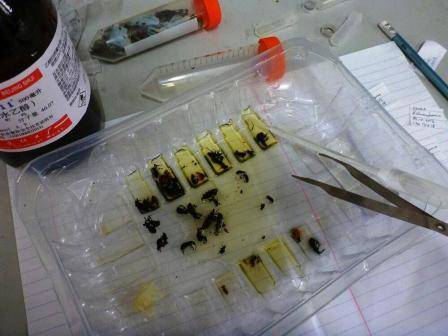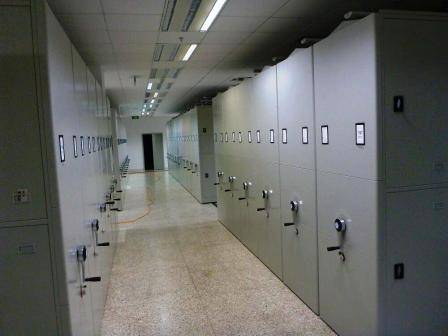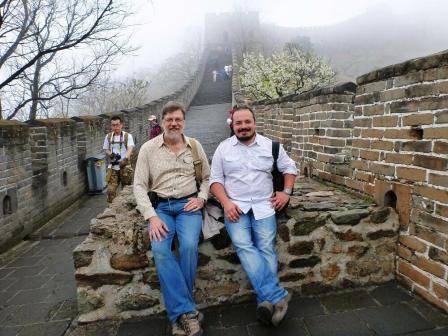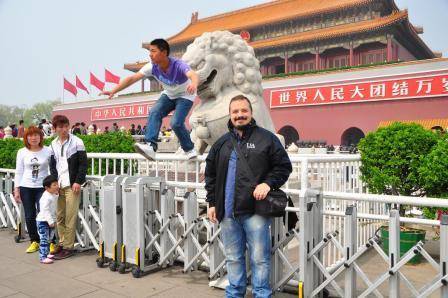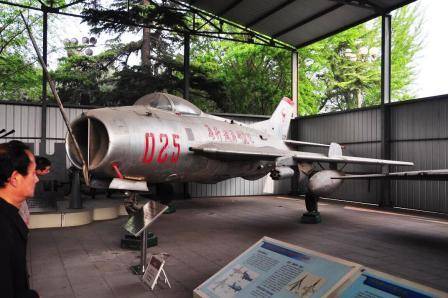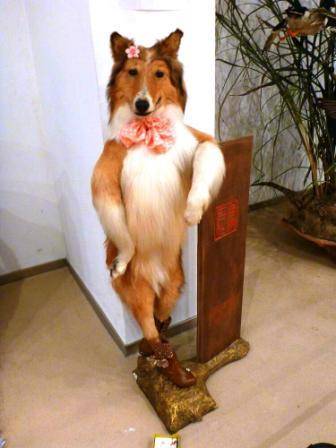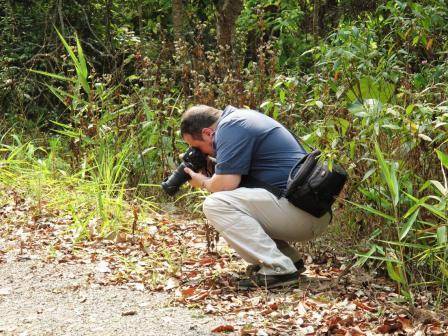Chris Lyal and Conrad Gillett last left us as they were returning to Beijing after a fortnight of weevil collecting in southern Yunnan. The final part of their blog details the last few days of their trip during which they were hosted by colleagues of the Institute of Zoology (IoZ) at the Chinese Academy of Sciences (CAS) in Beijing.
"After our collecting in tropical Yunnan, we arrived to a Beijing where spring had clearly sprung compared to the wintery scene we had left behind two weeks previously. The campus of the Academy of Sciences now looked decidedly green and flowery. We arrived in the evening and were quite tired from the journey and just wanted to get a good night's rest before a day in the collection the following day. We checked ourselves into the on-campus guesthouse, and managed to communicate with the lady at reception through her ingenious use of an online translation website - isn't technology sometimes wonderful!
After a good rest, the following morning we met up again with some of the entomologists at the Institute of Zoology. We were very hospitably looked after by Prof. Runzhi Zhang who is the principal investigator in the Group of Identification & Management of Invasive Alien Species. His colleagues Ren Li and Zhilian Zhang were also of great assistance during our stay.
The first thing to do was to sort, store and pack the weevils we had collected over the last two weeks. It is always interesting looking over the specimens again, as inevitably by the time a collecting trip is over, one has a faded memory of some of the early captures! The specimens were moved into fresh ethanol and all were carefully labelled and packed for the voyage home. We had a go at identifying some of the specimens, the Molytinae in particular, through comparison with preserved specimens in the IoZ collections, although with the limited amount of time we had, this proved a little frustrating and we ended up discovering a whole hoard of additional unidentified weevils as a result of our attempts! Chris’s bright idea of “a short paper covering the Mecysolobini of China since we caught a fair number and there are only 8 species here” was slightly dented by his discovery of 40 distinct unidentified species in the collections. The taxonomist's work is never done!"
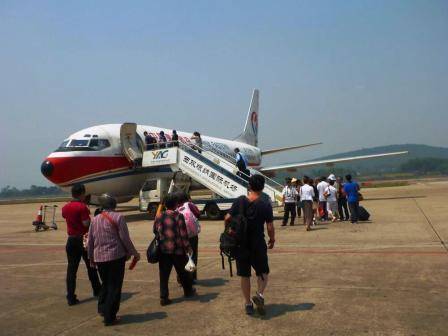
Chris boards our flight back to Beijing at Kunming airport, after the small debacle with his cabin bag detailed in part 2 of this blog!
The Institute of Zoology in Beijing - as can be seen, it is a very extensive and modern facility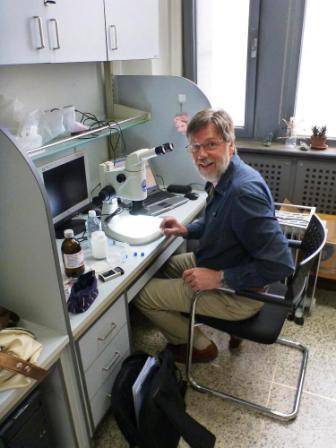
Conrad and Chris sorting, labelling and packing specimens
" The IoZ collections are housed in very good conditions, in a climate-controlled modern room. The specimens are arranged in wooden drawers kept in metal cabinets that are in compactor racks. It all seemed quite well organised. There was a large amount of interesting 'accessions' material which contained lots of weevils that had been identified to tribal level by Miguel Alonso-Zarazaga the previous year, and rather more that he had not managed to get to.
The modern collection facilities at the IoZ, with metal cabinets in compactor racking
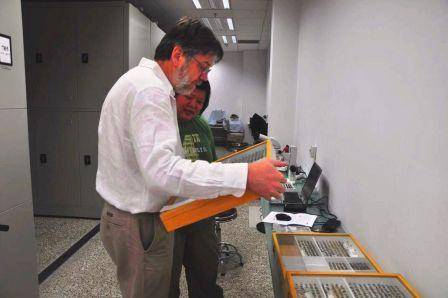
Chris and Ren Li studying weevils form the accessions material in the collections

The wooden drawers are housed in the metal cabinets
Did our colleagues get a chance to see anything of Beijing during their visit?
"We decided to take part of our last weekend in China off, having been on the go continuously for more than two weeks. One sight that we were both keen to see was the Great Wall of China and on Saturday morning we were very kindly taken there by three of the students in the department who were excellent guides (and translators!). We really would have struggled to make it there on our own as we were not keen on joining a big tourist guided tour. We were able to travel to a section of wall that remains mostly in its original state, which was preferable to the more easily reached sections that have been rebuilt. Our trip took place on a very misty Saturday, which whilst not being ideal for long uninterrupted views over the length of the wall's winding course, did impart somewhat of a mystical air to proceedings!
We eschewed the luxury of a cable car from the starting point to the Wall itself – had the mist been less we might have reconsidered this, but what turned out to be 1,400 steps later we made it to the top, and were able to explore more than two kilometres of the Wall itself .it must be said that after spending a few hours walking and climbing along the impressive structure (and then descending the 1,400 steps again) we were mostly pretty well spent! We both would like to thank Yang Ni, Zhang Jingjie and Xie Quanrong for a memorable visit to The Wall. And before you think to ask - yes we did find a beetle on The Wall (actually on Chris’s back)- what a great data label that will have!"
Our lovely guides, left to right: Xie Quanrong, Zhang Jingjie, and Yang Ni who took us to and showed us around The Wall
Chris and Conrad on The Wall
"On the following day, Conrad decided to see a few more sights in Beijing, including Tiananmen Square and the Forbidden City. He eschewed the (cheap) taxis for a trip on the Beijing underground system which was very modern and efficient, in addition to being air conditioned and very easy to navigate for a non-Chinese speaker/reader - and all this for 20p per journey! For the equivalent of the London underground tube ticket prices, Conrad could probably have travelled by private helicopter around the city!"
"The Forbidden City, the former palaces of the Chinese Emperors, was a stupendous sight - it is absolutely enormous, seemingly expanding wider the further you walk through it! Even after more than two hours , Conrad did not reach the end before having to turn back to head to the final stop on his self-made tour. This was to be the Military Museum of the Chinese People's Revolution as he has a penchant for the 'taxonomy' of military aircraft, and was pleased to be able to see some cold war era hardware, including a good number of fighter jets now peacefully gathering dust in their final resting places.
One entrance to the Forbidden City at Tiananmen Square - somewhat overshadowed by the acrobatic antics of the chap behind me!
Inside the (no longer) Forbidden City
Shenyang J-6 fighter gathering dust at the Military Museum
After the weekend it was back to work in the collections for a couple of days before returning to England. Chris met with the director of the IoZ to discuss future possible collaboration with the museum and discovered that the director has links with the UK because he spent time at the University of East Anglia, where both Conrad and one of Chris' daughters also study/have studied!
Runzhi Zhang also showed us around a laboratory and quarantine facility just outside Beijing which is used for pest-control research. The labs were very modern and equipped with very similar or identical equipment to what we have back home and is especially well set up for molecular genetics work. We were impressed not only by the modern PCR machines, gel-imaging cameras and freezers, but also by the cute pipette-tip bin! The facilities also included a large number of greenhouses where quarantine of pest interceptions can be undertaken.


Chris and Runzhi Zhang inspect the molecular laboratory in the pest and quarantine facility we visited - the cute pipette-tip bin is a nice touch!
"The Institute of Zoology has its very own Natural History Museum and we were able to make a short visit towards the end of our stay. The public galleries contained many well presented and labelled specimens and were very well maintained - it was impressive to see quite so many biological samples on show, mostly exhibiting the Chinese fauna. Insects were very well represented with a separate section for butterflies and one for beetles too - that is not common these days! Over the entrance to the beetle displays, a mammoth-sized bronze rhino beetle (Allomyrina dichotoma) was placed to welcome the visitor. Chris was particularly taken with the display of Zoraptera – possibly the only one in the World - which comprised a two-millimetre specimen inside a plastic vial positioned centrally in a large and otherwise empty case. Once inside, representatives of many beetle families were found in the wall-mounted displays, all neatly mounted and labelled.
However, even for both of us with decades-worth of beetle obsession behind us , it can hardly be denied that the most exciting, entertaining and bewildering exhibition was that in one of the temporary galleries. This gallery was presently in use housing the entries for an amateur taxidermy competition. That is something that you will not see every day! Although of course taxidermy has played an undeniably important role in natural history museum collections. The entries were remarkable and ranged from those portraying, in almost life-like realism, re-enactments of nature (with a definite bias towards fierce predators mauling their prey) to those that simply defy explanation, representing animals in decidedly unnatural poses, situations and even attire!"
The Institute of Zoology's very own Natural History Museum
A giant rhinoceros beetle guarding over the beetle collection!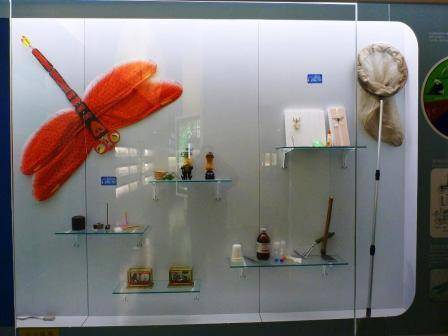
A display on insect collecting, complete with net, collecting tubes, pitfall cups, setting boards and other entomological paraphernalia
A highly dramatic and realistic taxidermy display of wolves hunting an ibex
An equally dramatic but not-so realistic entry in the taxidermy competition. Readers who are able to explain anything in this picture are urged to write in
"Before we returned to England, we were to experience one last culinary delight courtesy of our ever-charming colleague Ren Li, who very kindly took us out to lunch on our last day in Beijing to experience a gastronomic speciality of Hubei province: donkey. We were taken to a restaurant that specialised in equine epicurean delights such as donkey-skin soup, donkey kebabs (sort of) and donkey hot-pot! It was mostly very tasty but Conrad did struggle with the soup!
Ren Li at a table covered in donkey-based dishes - we thank her for her generous hospitality and for widening our horizons!
"And so, having added the last species to our 'eaten it' list, and packed our specimens for travel we bid farewell to all our friends at the IoZ and set off on our long journey home after experiencing a unique country and culture.
We would like to especially thank Runzhi Zhang, Ren Li, Zhilian Zhang as well as all the other people that helped us during our visit to China and without whom it would have been an impossibility. We now look forward to studying the specimens that we collected and hope that they will advance our knowledge of the systematics of that most diverse group of insects, the weevils.
Conrad
Chris
Panda
Photographs by Conrad Gillett, Chris Lyal and Ren Li




